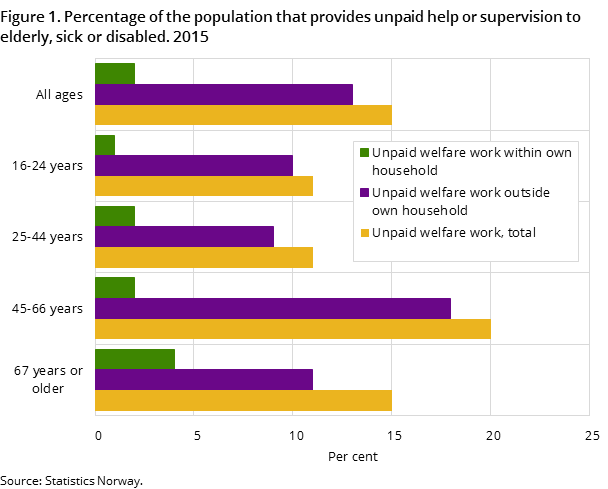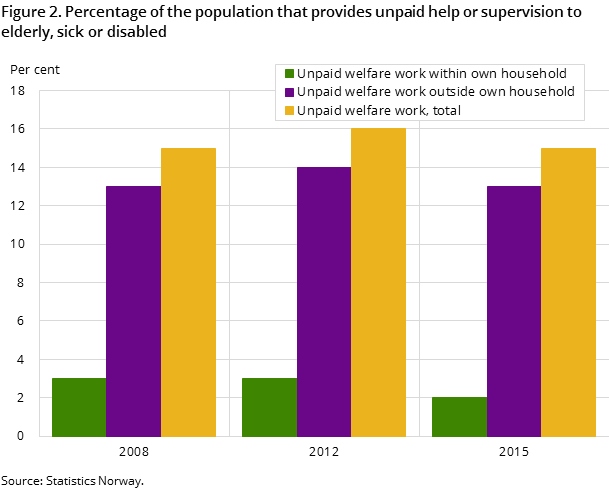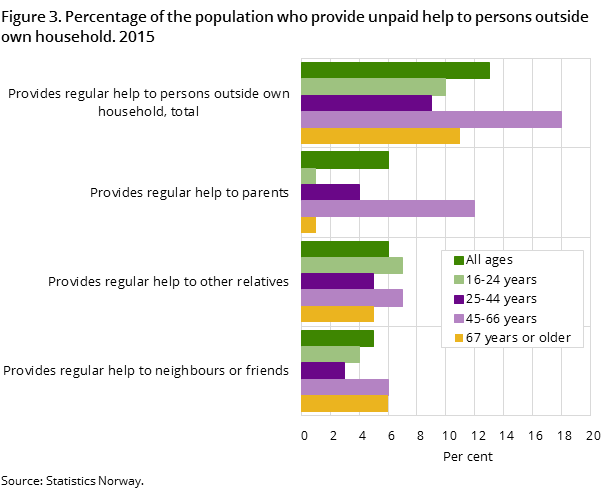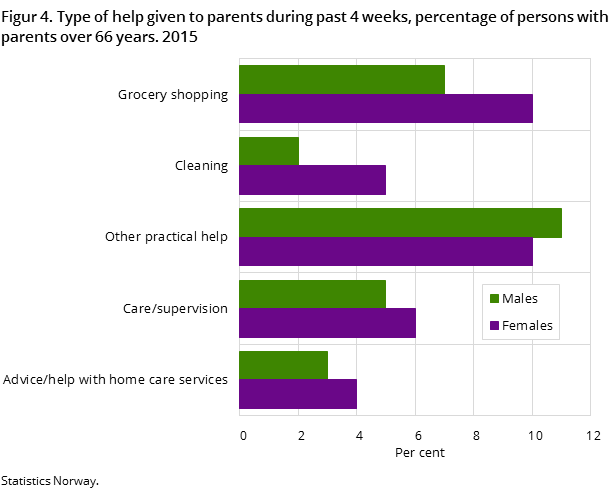Content
Published:
Updated:
This is an archived release.
Middle-aged perform most unpaid welfare work
One in six people regularly provide unpaid care to elderly, sick or disabled persons. The highest percentage giving such care is found in the age group 45-66 years, and most often they help their own parents.
| 2015 | 2012 - 2015 | |
|---|---|---|
| Share of persons | Change in percentage points | |
| Belongs to houshold where someone needs care or supervision (per cent) | 6 | 0 |
| Regularly gives unpaid help to person in need of care in own household (per cent) | 2 | -1 |
| Regularly gives unpaid help to person in need of care outside own household (per cent) | 13 | -1 |
| Regularly gives unpaid help, total | 15 | -1 |




According to the survey on living conditions, 15 per cent of the adult population carry out unpaid welfare work on a regular basis. Most welfare work is provided to persons outside the caregiver’s household. Two per cent of the population report performing welfare work for household members, while 13 per cent help persons outside their own household. Although life expectancy is increasing, the levels of unpaid welfare work are stable compared with previous surveys.
One in five middle-aged
Persons aged 45-66 more often provide unpaid care than both younger and older individuals. Twenty per cent in this age group regularly give unpaid help to someone who is elderly, sick or disabled, as opposed to 11 per cent in the younger age groups, and 15 per cent of those aged 67 years or older. Twelve per cent of persons aged 45-66 regularly help parents outside their own household, while 7 per cent report helping other relatives.
Care for elderly parents
When only persons who have living parents are taken into consideration, the percentage of persons aged 45-66 caring for their parents is 19. Among persons 67 years or older the corresponding percentage is 31. However, only 4 per cent in this age group have parents who are living, compared with 63 per cent of those aged 45-66 years.
Five hours per week
On average, persons who regularly provide help to others spend five hours per week on unpaid welfare work. There is no difference in average number of hours spent on care work between men and women, nor between persons in different age groups.
Mostly practical help
It is more common to assist parents with different practical tasks than to provide supervision or care. While 5 per cent of persons whose parents are 67 years or older helped their parents with supervision or care during the last four weeks, 8 per cent assisted with grocery shopping. Four per cent helped their parents with cleaning, and 10 per cent provided other types of practical aid during the same time span. Three per cent report giving their parents advice or other assistance with home care services.
Minor gender disparities
The percentage performing unpaid welfare work is approximately the same for men and women. Nevertheless, there are some differences in the type of help given. It is slightly more common for women to help their parents with grocery shopping – 10 per cent of women with parents over 66 years report this, versus 7 per cent of the men. Women also more often help their parents clean – 5 per cent of women with elderly parents help with cleaning, versus 2 per cent of men. Gender disparities are smaller when it comes to other practical help, care and supervision, as well as assistance with home care services.
Part-time workers do more unpaid welfare work
Comparing individuals according to their self-reported economic status, the highest percentage providing unpaid help to others is found among persons working part time. While 15 per cent of full-time workers perform unpaid welfare work, the same applies to 20 per cent of part-time workers. The disparity between part-time and full-time workers is greatest among men: 13 per cent of full-time working men report doing unpaid welfare work, compared with 22 per cent of men in part-time work. Among women, 17 per cent of full-time workers, and 20 per cent of part-time workers, report giving unpaid assistance to someone who is elderly, sick or disabled.
Slightly less unpaid welfare work in cities
The percentage that regularly provides unpaid help to someone who is elderly, sick or disabled is somewhat lower in urban areas than in other areas of residence. In total, 13 per cent of persons living in densely populated areas with at least 100 000 inhabitants do unpaid welfare work, compared with 16 per cent of persons living in smaller towns, and 15 per cent in sparsely populated areas. The disparities in welfare work load by area of residence are relatively small and may relate to variations in the distribution of the population across areas according to age and distance to family members in need of assistance.
Survey on living conditions on healthOpen and readClose
In 2015, the survey of living conditions on health was merged with the European Health Interview Survey (EHIS). This survey will be conducted every 6 years.
Sample and response rateOpen and readClose
Data from the health interview survey are representative for persons aged 16 or older living in private households. A sample of 8164 persons was interviewed by telephone. The response rate in 2015 was 59 per cent. More information is available under the tab About the statistics.
Contact
-
Mari Lande With
E-mail: mari.lande.with@ssb.no
tel.: (+47) 98 43 36 65
